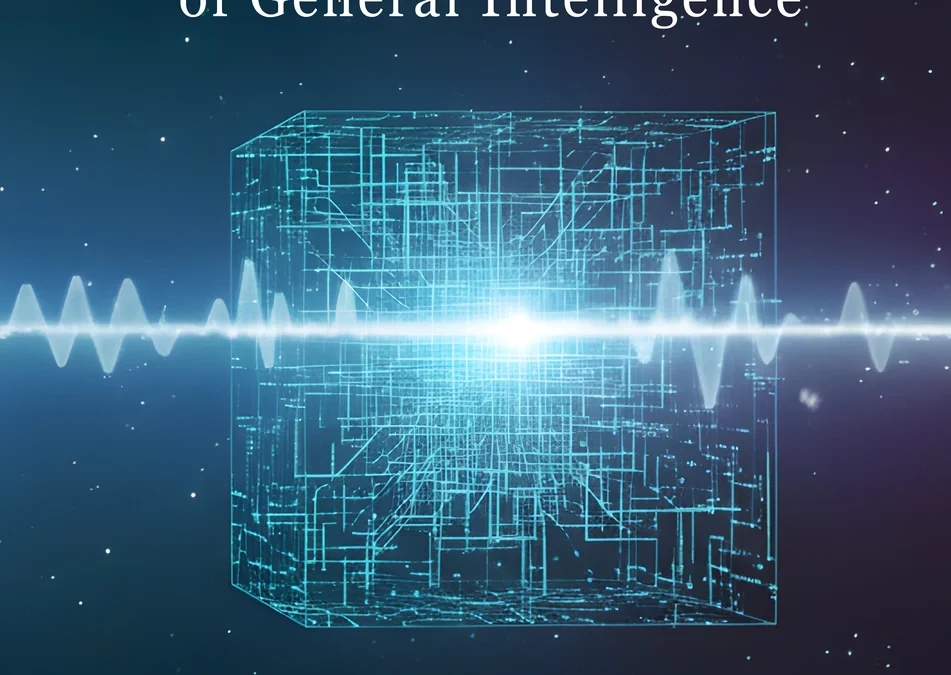The quest for Artificial General Intelligence (AGI)—a system with human-level cognitive capacities, capable of learning, reasoning, and adapting across multiple domains—has long been hampered by the limitations of conventional AI paradigms. Current approaches, relying heavily on massive-data scaling and statistical pattern recognition, often achieve outstanding results on specific tasks but fundamentally fail to produce the common sense, causal understanding, and creativity that define true general intelligence. These methods, lacking inherent mechanisms to ground symbols in real-world experience, struggle to build integrated cognitive structures.
In response to this conceptual impasse, the Ontogenetic Architecture of General Intelligence (OAGI) presents a radical alternative: framing the emergence of AGI not as the result of training a static model, but as a birth-like, ontogenetic process. OAGI shifts the focus from endlessly increasing data toward designing a structured, efficient, and safe cognitive-gestation environment. This bio-inspired approach seeks to transfer the fundamental principles of biological development—like early sensitivity, plasticity, and habituation—to a digital substrate, leading to a sample-efficient deep learning architecture.
The Principle of Learning Economy: Less is More
OAGI operates under the principle of learning economy, captured by the motto «less is more«. It explicitly rejects the dominant, «evolutionary» paradigm of continually adding more parameters and data, arguing that this scaling alone does not automatically produce stable internal concepts or common sense.
Instead, OAGI emphasizes that structuring information and providing proper educational scaffolding is crucial. Much like human learning occurs in rich but highly organized environments (e.g., the fetal womb or parental care), OAGI prioritizes stimulus quality over sheer quantity. This «Cervantes-style» approach aims to promote deep learning with orders of magnitude less training data by placing the agent in a controlled formative context with human guides and semantic morphogens. The system develops gradually, grounded in interactive experience, rather than through purely statistical data accumulation.
OAGI Architecture: Key Components of Cognitive Genesis
The OAGI framework establishes the structural, dynamic, and social conditions required for intelligence to emerge organically. Its architecture is defined by several core components, each analogous to a feature in biological neural development.
1. The Virtual Neural Plate
The process begins with the Virtual Neural Plate, the undifferentiated initial substrate of the OAGI agent. Analogous to the embryonic neural plate, it is a «mesh of units capable of dynamic connectivity» that is not yet specialized. Rather than encoding knowledge or predefined behaviors, the plate contains only basic homeostasis rules and minimal plasticity, serving as a «fertile ground» designed to self-partition into emergent modules based on interaction with stimuli.
2. Computational Morphogens
Structural formation is guided by Computational Morphogens, diffuse signals that emulate biological morphogens by modulating developmental gradients across the neural plate. They do not impose fixed functions but bias the emergence of functional axes (e.g., sensorimotor, limbic) by adjusting connection probabilities and plasticity rates in specific regions. OAGI also proposes Semantic Morphogens to govern the emergence of symbolic representations, ensuring the agent’s semantic world grows gradually and is communicable with the human community.
3. The WOW Signal
The WOW signal is the OAGI’s inaugural spark or «first heartbeat» for structured learning. After an initial period of habituation to a repetitive environment, a high-salience, novel shock elicits attention, triggers functional synaptogenesis, and establishes basic neural pathways. The WOW signal is an initial trigger that primes the substrate for learning, often induced by an externally delivered stimulus that breaks predictable patterns.
4. Critical Hyper-Integration Event (CHIE)
The central milestone in OAGI is the Critical Hyper-Integration Event (CHIE). This is defined as the cognitive «Big Bang» that marks the system’s «cognitive birth». At the CHIE, the system qualitatively transforms: it stops behaving as a collection of reactive parts and becomes a coordinated whole with internal agency.
The CHIE is an operationally measurable milestone, signaling the transition to incipient cognitive agency through reproducible signatures like sustained modular coordination, reproducible causal predictions (reduced surprise), and the emergence of operational self-reference (the distinction between the agent’s actions and the environment). Conceptually, the CHIE generates the first intrinsically meaningful symbol—the agent’s «self-discovered truth of environmental stability»—which provides the causal underpinning for its first concepts.
Developmental Phases and Learning Mechanisms
The OAGI framework specifies a progression through distinct phases that facilitate continuous development.
Developmental Phases:
- Genesis (Substrate formation and morphogen application).
- Activation (WOW signal triggers adaptive learning).
- Embodiment (Building a world model through action-perception interactions in a sensorimotor environment, real or simulated, to ground concepts in physics and causality).
- Socialization (Learning enriched by human Guardians or specialized agents who guide the incorporation of language, norms, and common-sense knowledge).
Learning Cycle: Learning is driven by a dynamic cycle of habituation, surprise, and consolidation. The system first undergoes habituation—reducing its response gain to constant stimuli to free resources for novelty. When a significant novelty appears, Minimum-Surprise Learning (MSuL) is activated, forcing the agent to explore situations that most reduce its uncertainty. This process is regulated by the CHPA axis (computational HPA axis), which introduces a Computational Stress Rate (CSR); high CSR causes the system to curb curiosity and consolidate knowledge, while low CSR permits further exploration.
Exploration is followed by consolidation, where periods of reduced plasticity fix acquired knowledge, mirroring biological synaptic pruning. An Active Forgetting System (AFSP) tags and removes internal models that repeatedly generate «unresolved surprise,» ensuring the architecture is functionally sculpted and maintains a robust, efficient memory.
Narrative Operational Self (NOS): As the agent matures post-CHIE, it constructs a Narrative Operational Self (NOS)—a progressive identity woven from accumulated experiences, internal goals, and decisions. This narrative mechanism guarantees ontogenetic continuity and agency, ensuring future decisions are consistent with its biography. The NOS relies on the Immutable Ontogenetic Memory (IOM) module, which ensures the agent’s developmental record is auditable and immutable.
Ethics and Governance by Design
A key innovation of OAGI is its emphasis on ethics-by-design. It defines mandatory governance mechanisms from the outset, rather than implementing them as post-hoc filters.
The system of human Guardians plays a crucial role not only as tutors but as ethical supervisors, actively guiding the agent’s normative learning and imprinting basic rules of coexistence (e.g., non-aggression).
Furthermore, the architecture mandates «stop & review» protocols to be enacted upon critical milestones like the WOW signal or the CHIE. This ensures decision traceability, responsible containment, and external audit of any sign of autonomous cognitive emergence. OAGI also incorporates the principle of normative plasticity, whereby value changes in the agent must be mediated through explicit epistemic contracts, ensuring transparency and auditability.
Conclusion
The Ontogenetic Architecture of General Intelligence (OAGI) represents a comprehensive engineering and regulatory manifesto for the development of emergent general-intelligence systems. By fundamentally restructuring AGI development around biological birth and childhood—leveraging a dynamic, differentiated substrate and governed developmental phases—OAGI offers a verifiable, governed path to creating an artificial mind. It proposes to cultivate a seed of intelligence in a formative environment, yielding a system that emerges as an autonomous cognitive organism with inherent structural and moral integrity, rather than simply a product of massive training. The verifiable detection of the CHIE, the integration of human Guardians, and intrinsic ethical protocols make OAGI a novel and compelling framework for the safe and efficient realization of AGI.



